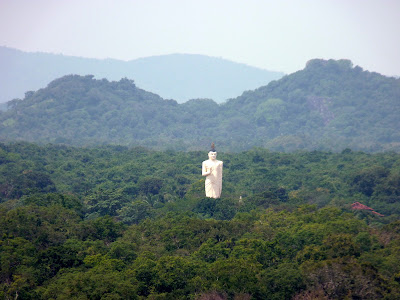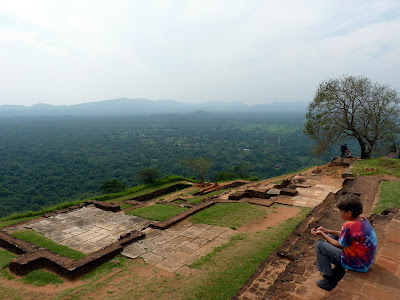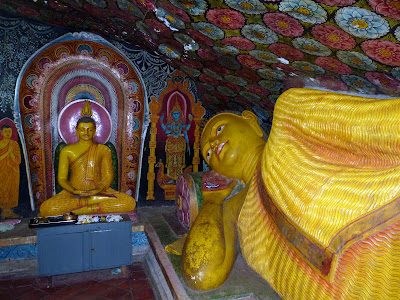 |
| One of the five cave temples at Dambulla |
The history of ancient Sri Lanka began with the shamed North Indian Prince Vijaya and his contingent of 700 men, who were banished from the subcontinent and left to drown in a bunch of broken-down boats. They fortunately found land on Sri Lanka's western shore sometime around 500 BCE, and their descendants settled in Anuradhapura in the dry northern plains. Legend has it they were saved by none other than the Buddha, who blessed them on the very same day he attained enlightenment. Using their engineering skills to build water channels and reservoirs, they prospered and established the first great Sinhalese kingdom. In the 3rd century BCE, the Sinhalese king converted to Buddhism, and since that time the Buddhist religion has played a central role in Sri Lankan life, culture and politics.
 |
| Before the climb up to the top at Sigiriya |
In turn, Sri Lankan Buddhism has had a profound influence on the practice of Buddhism in other countries. Early Sri Lankan monks created the classical literature of the Theravada school of Buddhism, one of the two main strands of Buddhist thought. Theravada Buddhists from across southeast Asia still look to Sri Lanka for spiritual guidance.
So, what does all this have to do with the Bruner Family Journey? No, we haven't converted to Buddhism. But, we did enjoy spending six days methodically tracking down the remains of Sri Lanka's ancient Buddhist civilization, which thrived for well over a millennium, from the 3rd century BCE until the 12th century CE. After that time, Sinhalese power on the island fractured and shifted towards the south and west. The Europeans then took over several centuries later, save for the last remaining vestige of Sinhalese independence, the kingdom of Kandy (which is covered in our last post).
 |
| More from Dambulla |
Our first two major stops on the “Ancient Cities” trail were Dambulla and Sigiriya. The history of the cave temples of Dambulla dates back to the first century BCE, when the Sinhalese king took refuge in the caves, after temporarily being driven out of the royal capital (Anuradhapura) by southern Indian invaders. When the king regained his throne, he had the caves transformed into a complex of Buddhist temples. The temples have been in continuous use since that time and major additions have been made over the centuries. The site consists of five caves high up on a sloping rock face, with a total of about 150 painted and sculptured Buddha images. The simple white exterior belies the magnificent interiors, which burst with vivid colors and elaborate decorations – and a whole lot of Buddhas. But apparently, some thought the site needed one more Buddha, so a modern 30-meter high Buddha statute was recently added at a new temple at the base of the rock face.
 |
| Talia at the top of Sigiriya |
Sigiriya has a more enigmatic history. We know it's a huge monolithic rock with ancient gardens, caves, frescoes and building foundations, but it's not certain what it all was used for. Many believe it was a royal fort and palace built in the 5th century CE by King Kassapa, after he killed his own father to take the throne. It's an exciting story (Jeremy definitely liked it), but the archeological evidence seems to support another theory – namely, that it was a Buddhist retreat and monastery dating back to the 3rd century BCE. Either way, it's an epic place – those who make the long, steep, hot climb to the summit are rewarded with a spectacular view and a strong sense of awe.
 |
| View from Aluvihara |
On our way up from Kandy to these two monumental sites, we stopped at two lesser attractions. The first was the Aluvihara monastery, a set of ancient monastic caves carved out of giant boulders that fell long ago from the mountains above. The setting is very picturesque and the kids liked it because they got the chance to climb on some rocks. On a darker note, in 1848 the British, in suppressing a revolt, destroyed an important library of Buddhist manuscripts that Sri Lankan monks created at Aluvihara in the first century BCE. The work of recreating the library continues at the monastery to this day. The second site was the Nalanda Gedige, a 1,000-year-old stone building that looks very much like a South Indian Hindu temple, but contains no Hindu images and is instead believed to have been used as a Buddhist temple.
In the children's eyes, however, all of these grand historical monuments paled in comparison to the large, warm swimming pool at the Gimanhala Hotel in Dambulla. The pool's sleek contemporary design would not have seemed out of place at a stylish California resort - except for the surrounding rice fields and rusty farm equipment and the sound of tuk tuks whizzing by right in front of the hotel on Dambulla's dusty main drag...
 |
| The pool at our hotel in Dambulla |
 |
| View from the pool |
 |
| Here are more pictures of Dambulla |

















































No comments:
Post a Comment